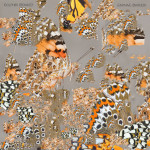Various Artists : Pacific Breeze 2—Japanese City Pop, AOR & Boogie 1972-1986

Light in the Attic Records does not put out albums for music fans. They put out albums for music historians. Since the label’s creation in 2002, their reissue campaign has breathed new life into long-lost classics like Betty Davis’ Nasty Gal, Karen Dalton’s In My Own Time, and, um, the Deep Throat soundtrack. (Their Modern Classics Recordings imprint has reissued more recent and well-known material, including Mercury Rev’s Deserter’s Songs, This Heat’s entire catalog and D’Angelo’s Voodoo.) But Light in the Attic also lovingly curate compilation albums of rare, out-of-print or otherwise forgotten recordings from around the world, from South Korean psychedelia to folk rock from Canada’s First Nations indigenous peoples. Last year, the label put out two brilliant collections from Japan: Kankyō Ongaku—literally “environmental music”—explored ambient music from the 1980s, while Pacific Breeze offered an introduction to the country’s city pop scene, fusing soft rock and smooth jazz. And now, Light in the Attic has issued a sequel to Pacific Breeze that expands—and maybe even improves—upon the original.
The first volume of Pacific Breeze covered city pop’s halcyon years, from 1976 to 1986, and the second volume stretches a little further back into the past. By 1972, the Beatles- and Bob Dylan-influenced “group sounds” period of Japanese popular music had come to an end, and several of the country’s most prominent rock and folk-rock bands had broken up. As the decade went on, the creation of new technologies like Sony’s Walkman and Yamaha’s early synthesizers (namely the GX-1 and the CS-80, followed by the DX7 in 1983) not only continued Japan’s post-war economic growth, but changed the sound of Western popular music: the transition away from British Invasion-influenced rock ‘n’ roll to the more distinctly American genres of soft rock and smooth jazz was already underway, but the proliferation of synthesizers and keyboards made it happen even faster. When these new musical movements came to Japan, they became the soundtrack to an era of conspicuous consumption, much like jazz during the Roaring Twenties—an era that came to an end when the country’s asset price bubble burst in the early 1990s.
Of course, city pop, like jazz, can feel less like a genre and more like its own musical ecosystem, and the sheer number of artists and related styles it contains can make it daunting for newcomers. With this in mind, picking just 16 (or even 32, taking Pacific Breeze’s previous installment into account) city pop tracks feels like barely scratching the surface; this feels much more like a mixtape than a definitive overview. (It would also be helpful if these songs were chronologically sequenced, so as to give a better sense of how city pop changed over time. That being said, this is a Light in the Attic project, which means the immaculate packaging and detailed liner notes are worth the price tag.) But that doesn’t mean the songs on Pacific Breeze 2 aren’t a great place for newbies to start, nor does it make them any less fun to listen to. Folks with a grudge against yacht rock are advised to find another record to spend an hour with, but fans of The Doobie Brothers and Donna Summer—or, more recently, Thundercat and Daft Punk’s Random Access Memories—will be vibing with Pacific Breeze 2 from the first curlicues of electric guitar on the opening track, Bread & Butter’s “Pink Shadow.”
Unlike most sequels, Pacific Breeze 2 plays it straighter than its predecessor despite covering more ground. Where the first installment threw some synth-pop and techno into the mix (you can hear bits of Kraftwerk’s Computer World in “Sports Men”, one of two Haruomi Hosono songs on the compilation) the second is less experimental, but it still covers plenty of stylistic ground. Two of Hosono’s most important collaborators make contributions: Eiichi Ohtaki (Happy End) puts a tropical spin on The Zombies’ “Time of the Season” with “Yubikiri,” while The Sadistics’ “Tokyo Taste,” with Yukihiro Takahashi (Yellow Magic Orchestra) on drums, does plastic soul about as well as David Bowie’s Young Americans. Tatsuro Yamashita—sometimes called the “king” of city pop”—only appears as a co-writer (the omission of anything from his solo album Moonglow or his collaboration with Hosono and Shigeru Suzuki, Pacific, feels like a missed opportunity), but “Vibration (Love Celebration)” is terrific, with an indelible Steely Dan groove and breathy, sultry vocals from jazz vocalist Kimiko Kasai. (If you can track down Butterfly, Kasai’s 1979 album with Herbie Hancock, it’s well worth the effort.) And then there are the songs like Tetsuji Hayashi’s “Hidari Mune No Seiza” and Piper’s “Hot Sand”, which you can trace all the way to the development of vaporwave nearly three decades later.
On a purely musical level, Pacific Breeze 2 does what you’d hope a collection of pop songs, city or otherwise, would do: Even if I can’t understand the words to most of the songs, I enjoy listening to the album and can easily see myself playing it for friends at a backyard cookout or pool party (once it’s safe to be social again, of course). But other than enjoyment, there’s something else I feel listening to these songs. It isn’t nostalgia—I’m an American who’s encountered Eighties pop and vaporwave before, but never city pop. To encounter these songs, here and now, is to view the globalization of popular music from another perspective: not how Western pop musicians absorbed (or appropriated) African and Indian sounds to sell to Western audiences, but how Japanese pop musicians earnestly took “American” sounds and used them to create something artificial but authentic, foreign but familiar. They once looked to and sounded like an optimistic future, but now function as artifacts from before the collapse.
Label: Light in the Attic
Year: 2020
Similar Albums:
 Thundercat – It Is What It Is
Thundercat – It Is What It Is
 Daft Punk – Random Access Memories
Daft Punk – Random Access Memories
 Dolphin Midwives – Liminal Garden
Dolphin Midwives – Liminal Garden
Jacob Nierenberg is a man of contrasts: a Pacific Northwesterner who carries an umbrella, a pacifist who enjoys the John Wick movies, an idealist who follows politics. Scarcely a day goes by that he doesn't talk with his best friend (and fellow Treble contributor) Tyler Dunston, the Jim Morrison to his Bernie Sanders.

